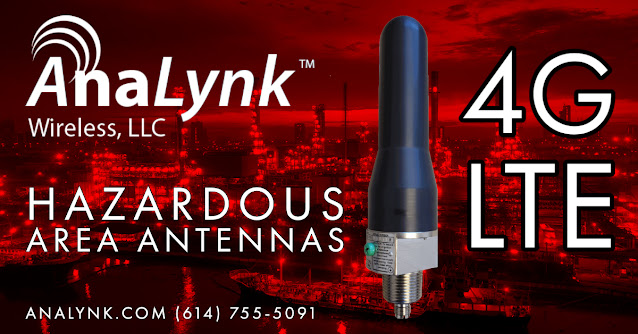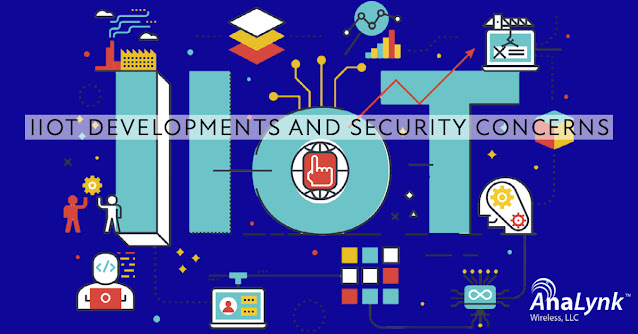Analynk Wireless manufactures hazardous area wireless access point enclosures and hazardous area wireless antennas. Analynk is also a certified UL508A panel manufacturer providing high quality control panels to Ohio and surrounding areas. For more information, visit the Analynk website here or call 614-755-5091.
The Analynk AP431 Dual-Band Hazardous Area Enclosure for the Cisco C9115AXE Access Point
- Pharmaceuticals
- Oil refineries
- Oil & Gas Platforms
- Chemical Plants
- AP431
- AP431-ATEX
- AP431-N4 (NEMA 4X rating)
CTX/CTM Series Hazardous Area 4G LTE Explosion Proof Antennas
The Analynk CTX/CTM 4G LTE antennas are designed for use in “Hazardous-Classified” and Industrial-Hardened applications. The antennas are omnidirectional, with an average gain of 1.27dBi with a peak gain of 2.46 dBi. Two antenna versions are available, the CTX series has a 3/4” NPT mount, and the CTM series has an M20 mount. The antennas can be mounted on an Explosion Proof enclosure or conduit. The mounting base is made of heavy nickel-plated brass with an integrated TNC-F connector for ease of installation. The radome is optimized for rugged industrial applications while maintaining maximum radio frequency transmission and reception efficiency. The antennas have a built in Explosion Proof seal and may be mounted up to 18” away from the enclosure without an additional seal.
Get more information and download a specification sheet here.
Analynk Wireless
(614) 755-5091
Analynk AP420 Explosion Proof Access Point Enclosure For Meraki/Cisco MR42E
The AP420 is a hazardous area enclosure designed to house the Meraki/Cisco MR42E dual band access point.The enclosure and antennas are rated for Class I, Div 1, groups C & D Hazardous Locations. All hardware, mounting plate, and RF cables are provided to make installation of the access point quick and easy. The enclosure includes five hazardous area 2.4GHz/5GHz antennas, the MR42E is not included.
Ratings: Class I, Div 1 Groups, C & D, ATEX Zone 1 optional
Applications:
- Pharmaceuticals
- Oil refineries
- Oil & Gas Platforms
- Chemical Plants
Ordering information:
- AP420
- AP420-N4 (NEMA 4 rating)
- AP420-ATEX
For more information call Analynk at 614-755-5091 or visit this web page.
Industrial Wireless Networking Considerations
Implementation of complex monitoring and control processes by industrial automation systems in the chemical industries, power plants, oil refineries, and water delivery systems are typical. The industrial networks for process automation at these sites typically encompass broad areas, with highly dense networks with hundreds or thousands of nodes.
The harsh industrial environment presents several obstacles for wireless communications, the most significant of which are dependability, fault-tolerance, and low latency. Unpredictable changes in temperature, humidity, vibrations, and pressure and the presence of highly reflective (metal) items and electromagnetic noise make industrial surroundings stressful.
In these installations, thousands of devices provide measured values (such as temperature, pressure, flow, and location) to actuators that control processes and servers that coordinate the manufacturing steps. Wiring is often tricky and expensive, particularly in combustible and explosive areas (for example, in the presence of flammable gases in an oil refinery.) Remote or inaccessible places are difficult to reach, and mobile nodes can only be connected intermittently. Even though the amount of data is relatively low in an industrial application, dependability and latency are crucial, and complete data delivery in real-time is a must.
Key constraints that hinder the actual deployment of wireless networks in such settings are battery capacity and device power consumption. Communication and power wires, ideally, can be eliminated to provide a completely wireless system. To that end, the devices should be energy efficient and capable of running for years on a single charge from a battery. Furthermore, wireless networks bring logical benefits to maintenance and commissioning, such as "plug-and-play" automation systems to reduce downtime and speed up tests, as well as "hot-swapping" malfunctioning modules.
Wireless Communication Terminology and Definitions
Antenna – A device that converts electrical energy into propagating electromagnetic waves or the reverse.
Antenna Polarity – The orientation of the directionality of electromagnetic waves produced by an antenna. Common polarities are vertical, horizontal, and circular. Receive antennas should be oriented such that its polarity matches that of the transmitting antenna polarity.
Bandwidth – The amount of spectrum occupied by a signal. For example, a standard IEEE 802.11g transmission will use a nominal 22 MHz of bandwidth. An IEEE 802.15.4 transmission on which ZigBee, WirelessHART, and ISA100 Wireless are designed will use a nominal 5 MHz of bandwidth.
Carrier – A single frequency sinusoidal signal represented by a vertical line or spike in frequency.
Channel – A term used to identify a physical communications link and includes the characteristics of the entire path of information flow from transmitter to receiver. A channel is defined by electrical and electromagnetic characteristics of the transmission medium such as bandwidth and distortions.
Interference – RF power, typically in the RF band of interest, that disrupts communications by inhibiting the ability of a receiver to decode a transmission. Sources of interference could include anything that radiates electromagnetic (EM) energy such as machinery and undesirable radio devices.
Signal-to-Noise Ratio (SNR) – Ratio of signal power to naturally occurring emissions such as thermal noise and cosmic background radiation. Maximizing SNR is the primary goal of wireless communications.
Signal-to-Noise-And-Interference Ratio (SNIR) – Ratio of signal power to the sum of naturally occurring noise power and interference power. Minimizing the contribution of interference to SNIR is an important goal of a wireless communications system.
Power Decibels – A logarithmic representation of a voltage or power relative to a reference. Power is converted to decibels by the equation 10 P 10log p . The notation dBW and dBm represent power levels relative to 1 Watt and 1 milliwatt, respectively. The notation dB denotes a ratio of two numbers and should not be used to denote power.
Link Budget – Calculations that predict the probability that a transmission will be successfully detected and decoded by the receiver. A link budget will account for transmission power, signal formatting, noise, signal distortions, interference, receiver characteristics, and the link reliability requirements.
Link Margin – The difference in decibels (dB) between the ability of a receiver to successfully receive a transmission and the expected minimum received power. A link margin of 10 dB indicates that a signal could be attenuated by an additional factor of 10 before it can no longer be received. A link margin should accommodate reasonable unexpected attenuations, distortions, and interference not directly addressed by the link budget.
Transmitter – The device responsibility for transmitting information wirelessly.
Transmit Power – the average amount of RF energy per unit power emitted by the transmit antenna. This is typically specified in Watts, dBW, or dBm.
Bit Rate – The average or peak amount of data transmitted during an interval of time. This is represented as bits per second (bps).
Duty Cycle – The percentage at which a transmitter is active.
Modulation – The method by which information is used to modify the behavior of an RF carrier. Different modulations exist such as amplitude modulation (AM), frequency modulation (FM), and phase modulation (PM). Digital modulations are discrete versions of the above modulations. Common modulations used in industrial communications include binary phase shift keying (BPSK), quadrature phase shift keying (QPSK), and quadrature amplitude modulation (QAM), among others. Wi-Fi uses a combination of BPSK, QPSK, and QAM depending on channel quality.
Error Control Coding (ECC) – A method to increase reliability of a communications link by adding data redundancy that can detect and correct errors produced by the channel. ECC increases the amount of bandwidth requirements or decreasing the amount of useful information over a channel.
Frequency Hopping (FH) – A process by which the carrier frequency is changed during or between transmissions accordingly to a pre-defined synchronized method. With FH, transmitter and receiver must tune to the same frequency at precisely the same time. FH hopping adds a layer of complexity to a system but also makes interception or disruption of the wireless system more difficult, thereby making the system more reliable.
Spread Spectrum – A process of spreading RF energy beyond what is needed to transmit information for the purpose of improved medium access, better interference immunity, or minimization of signal detection.
Payload – The information being transmitted. The size of the payload factors into transmission duration. All communication systems have a limit to the size of a payload before fragmentation is required. Not all communication systems support fragmentation. At the lowest layers of a communication system, the payload includes all data encoding and framing.
Receiver – The device responsible for decoding incoming transmissions in accordance with an established protocol.
Received Signal Strength Indicator (RSSI) – A measurement of received signal power.
Received Signal Quality Indicator (RSQI) – A measurement of the quality of the received signal
Sensitivity – The minimum signal strength, SNR, or SNIR required by a receiver to decode an incoming transmission.
Adjacent Channel Interference (ACI) – RF energy that is adjacent to the channel containing a desired signal.
Adjacent Channel Rejection (ACR) – The ability of the receiver to suppress ACI.
Dynamic Range – The difference between the maximum and minimum received signal power. A large dynamic range is particularly helpful in accommodating strong ACI that leaks past RF filtering.
Selectivity – The ability of a device to decode a transmission on one frequency without interference from transmissions on other frequencies.
Reprinted from Guide to Industrial Wireless Systems Deployments by the National Institute of Standards and Technology.
(614) 755-5091
Analynk AP626 Explosion Proof Access Point Enclosure For Aruba AP-514
The Analynk AP626 is a hazardous area enclosure designed to house the Aruba AP-514 dual band access point. The enclosure and antennas are rated for Class 1, Div 1, groups C & D Hazardous Locations. All hardware, mounting plate, and RF cables are provided to make installation of the access point quick and easy. The enclosure includes four of our patented hazardous area 2.4GHz/5GHz antennas, the AP-514 is not included.
Ratings: Class I, Div 1 Groups, C & D
ATEX Zone 1 optional
Applications:
- Pharmaceuticals
- Oil refineries
- Oil & Gas Platforms
- Chemical Plants
Ordering information:
- AP626
- AP626-N4 (NEMA 4 rating)
- AP626-ATEX
Coming This June: Analynk's Hazardous Area 4G LTE Antenna
Analynk Wireless, an innovative manufacturer of hazardous area antennas and access point enclosures and wireless instrumentation for the process control industry, announced a 4G LTE antenna rated for Class I, Division 1 Groups C & D, ATEX, and IECEx Zone 1 areas.
4G, which stands for "Fourth Generation," is a standard developed by the International Telecommunications Union (ITU) in 2008, established explicitly by the ITU-R. (which deals with radio communications). Today, 4G is better known for its broadband capabilities and dramatically higher speed than 3G, which pioneered data access in the cellular space.
The ITU standard mandated a minimum download speed of 100 Mbps, which was highly hypothetical at the time. In reality, several years later, carrier networks are only now realizing these goals. A wireless network must be capable of downloading at a rate of at least 100 Mbps to qualify as true 4G.
Analynk will introduce the new product this June 2021.
For more information, contact Analynk Wireless, LLC, 790 Cross Pointe Road, Columbus, OH 43230
Call them at 614-755-5091 or visit https://analynk.com.
Antennas Designed for Hazardous-Classified, Industrial Hardened Applications
Wireless communication has seen increasing prevalence in the industrial process measurement and control field for several years. It has provided years of reliable communications for monitoring and controlling processes, where using cables is either too costly or impractical. The absence of wires saves space, reduces the potential for damage, and simplifies modifications to the equipment layout. Implementing wireless communications in hazardous areas, whether through WiFi or other radio frequency channels, presents a particular set of challenges to successful implementation. Points of network access and further transmission and receiving equipment can require a level of isolation and hardening appropriate for the hazardous environment. In response to customers' desire to incorporate the technology across an ever-widening array of application scenarios, vendors continue developing and releasing new products and technologies that expand the potential for industrial wireless communication.
Many industrial process control operations can benefit from wireless connections between measurement and control devices. Analynk Wireless provides patented hazardous area explosion-proof antennas for industrial installations. Analynk antennas are operable across an extensive temperature range and provide substantial impact resistance, signal output, and third-party ratings for hazardous environments. These rugged antennas are for global application in the industrial process control field. Analynk hazardous area antennas are very robust and intended for industrial applications. All hazardous area antennas have UL listed Class I, Groups C and D, ATEX/IECEx Certification, and range of frequencies available- from 900MHz, 2.4GHz, and Cellular GPS, 4G, Iridium, and dual bands.
For more information, contact Analynk Wireless.
(614) 755-5091
IIoT Developments and Security Concerns
Upward of 27 billion devices connect as part of the massive confluence of technologies, networks, protocols, standards, and devices known as the Internet of Things (IoT). IoT is a network of computers and devices that capture and exchange vast volumes of data, which is then sent to a cloud-based service, aggregated with other data, and then exchanged with end-users to provide valuable insights. IoT is growing automation in homes, classrooms, shops, and several other industries and industries.
The Industrial Internet of Things (IIoT) leverages many of the same technologies like IoT and applies them to the industrial world's diverse needs. IIoT is a category of technologies that capture and distribute data inside historically isolated industrial devices, contained in Supervisory Control and Data Acquisition (SCADA) systems and other Industrial Control Systems (ICS). They track and control essential industrial infrastructure, including factories, power plants, water systems, ports, other industrial installations, and some U.S.
Sensitive industrial infrastructure owners and operators are rapidly implementing IIoT technologies to maximize the development and distribution of goods and services, increase performance, improve safety and minimize costs. IIoT sensors and devices provide real-time monitoring and control to operators. They also collect data on system output, further improving plant performance or production performance. For example, smart tools used on a production line could allow a company to monitor and evaluate its production process. Real-time production data could provide insight into plant conditions, discover additional plant capability, and predictive analytics can help detect corrosion within the refinery pipe.
These threats to modules, firmware and software, wireless networking, and most devices must include mitigation at the computer and system engineering level. The U.S. National Institute of Standards and Technology (NIST) and the European Union Agency for Cyber Security (ENISA) seek to guide the government and industry with some of their voluntary attempts to describe IIoT cybersecurity. Industry is collaborating with original equipment manufacturers (OEMs) and other manufacturers to establish reasonable safety capabilities in IIoT products to avoid burdensome regulations that are likely to quickly get out of date as the IIoT industry is vast and changing much faster compared to government legislation.
Key Concerns
- Critical infrastructure owners and operators are rapidly adopting the IIoT to boost performance and maximize productivity, but this technology also brings increased cyber and other vulnerabilities.
- The increased adoption of the IIoT, historically unsafe and isolated legacy systems come with new connected devices against a background of diverse yet growing safety standards for components, creates further possibilities for system access and eventual critical infrastructure access to the computer network by several malicious cyber players.
- The rise in publicly and commercially accessible cyber resources makes it easier for more players to access vulnerable IIoT components. These devices are contained in critical infrastructure, allowing them to seek a range of effects that may not be detected, and present financial and possibly physical consequences.
Evaluation of the Technologies Potentially Suitable for IWSAN Solutions Covering an Entire Industrial Site With Limited Infrastructure Cost and Trade-Offs
An excellent 2020 publication from the National Center for Biotechnology Information, U.S. National Library of Medicine on industrial wireless technologies:












